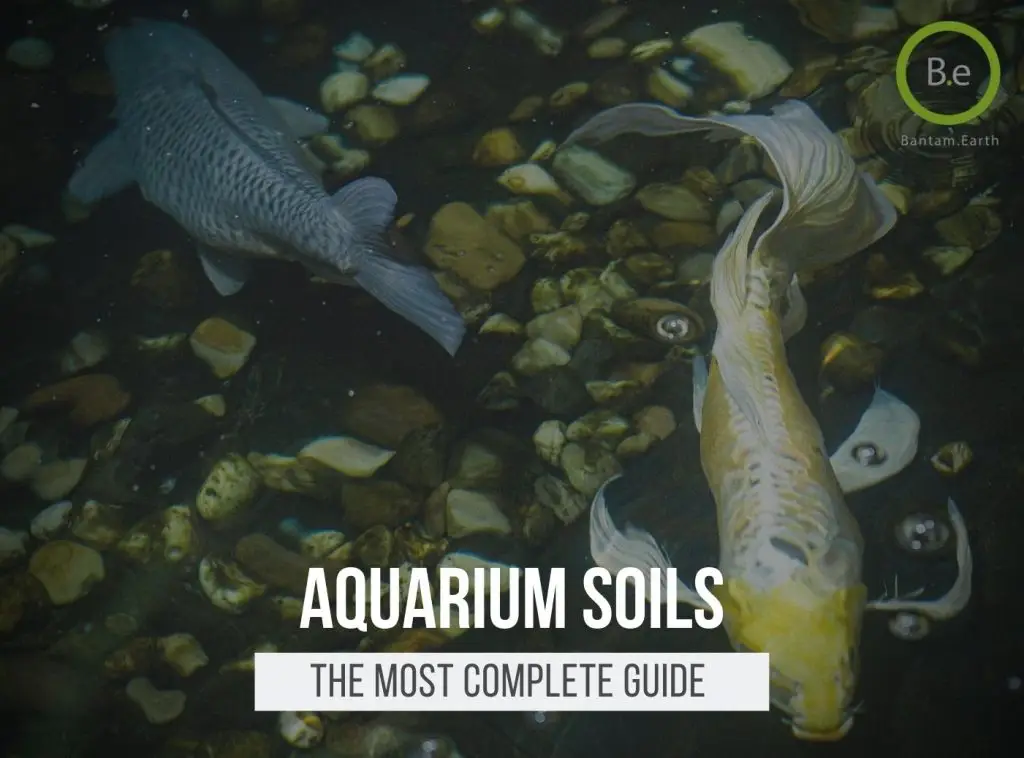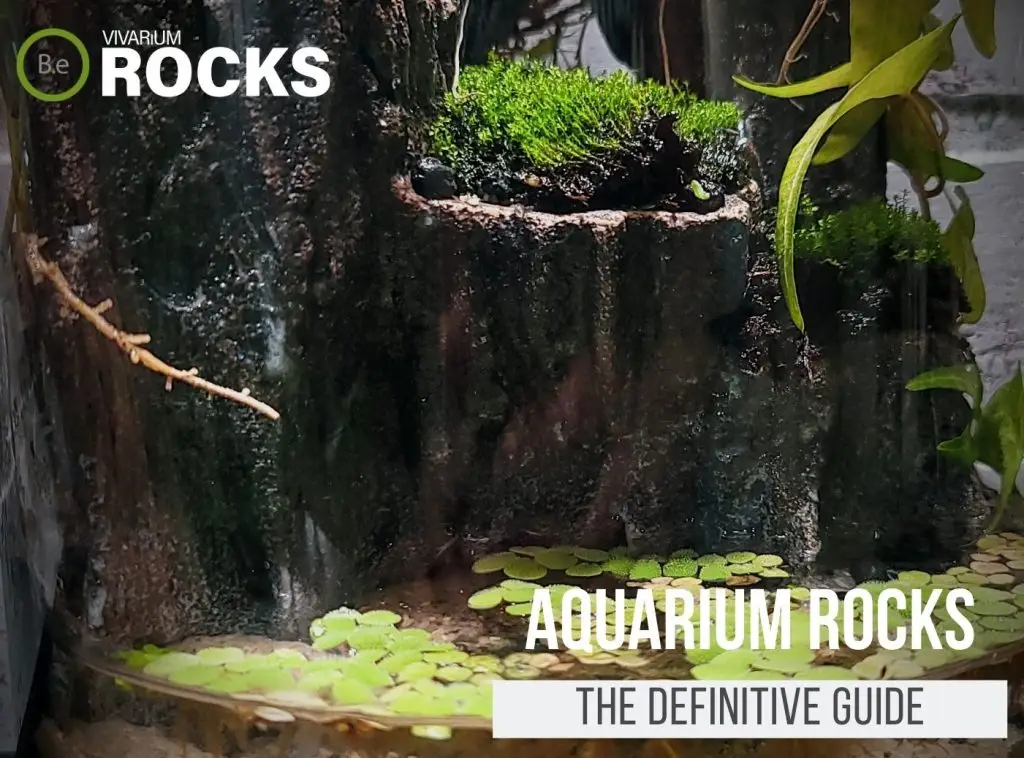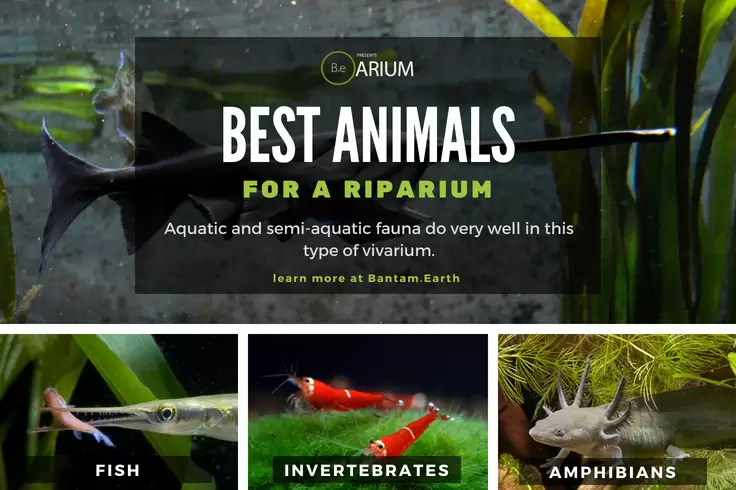So many of you are interested in pushing the limits with your aquarium but aren’t quite ready for the responsibilities of a full-blown paludarium. A riparium might just be the perfect in-between! This edition of vivarium types will explore the intimate details of riparia as well as demonstrate how to put on together.
Table Of Contents:
ToggleWhat Is A Riparium?
A riparium, also commonly referred to as “riparia”, is a type of vivarium that consists of water with some land features. The Ripa part of the word comes from the Latin word riparius, meaning “bank” or “shore.” The word itself translates to “a shore-like place.” The plural form of riparium is riparia.
Like paludaria, this planted tank also consists of both water and land. The aesthetic goal of a riparium is to mimic a shoreline or riverbank. Think of this vivarium as more of an aquarium with a portion of its plants and hardscape above water.
Riparium Vs. Paludarium: What’s The Difference?
Paludaria and riparia are very similar in the sense that they both consist of aquatic and terrestrial features. There is, however, a difference in life sustainability.
A paludarium has enough landmass to provide a habitable living space for semi-aquatic animals. A riparium has a limited landmass but usually cannot support life that depends on “Terra-amenities” (yes – I made up that word).
If ripariums are thought to resemble a riverbank, think of a paludarium as an island on water or a lake within a jungle. I go more into depth about paludaria here.
Constructing a Riparium
Building a basic riparium is a very straightforward process. You have two key elements that make up the planted tank, the water, and the canopy. Unlike the paludarium build, there will not be a solid land portion to focus on with this design. let’s start with the basic elements necessary for our setup:
Key Elements
The Water part of the riparium is the cornerstone of this ecosystem. Animals living within this tank will be mostly aquatic. Therefore, the enclosure will consist of a good percentage of this section.
This area will not only provide housing to all plants and animals but also a substrate. The substrate will serve as the base support for the plants that stem into the canopy section.


The Canopy part of the tank is what makes ripariums unique from all the other vivariums. Very few semi-aquatic inhabitants will find a use for this area of the enclosure. Plants, on the other hand, will thrive off the endless amounts of CO2 available here.
The very aspect that makes this area possible is the emerging objects divulging from the water portion. Hardscape materials like rocks and wood are commonly used to bridge the aerial and aquatic features together within this setup.


Aquarium Conversion
An easy way to build a riparium is to convert an existing aquarium. Simply adding floating logs, or stacking rocks up to the water line would be enough to get the conversion going. Certain aquatic plants will grow past the water line and into the aerial section of the vivarium.
One way of scaping an aquarium into a riparium is to think of the river or coast you’re trying to mimic and build according to that thought. Draining a large portion of the water until plants and hardscapes begin to reveal themselves at the surface is another way to instigate the conversation.
Types Of Ripariums
Initially, there are two types of riparia setups… The open enclosure and the closed enclosure. They both have their advantages but for the most part, The decision on which setup you will proceed with will come down to cosmetic and tank location.
Riparia should be designed with intention of catering to tall plants. Vertical space should be the priority with these types of vivaria.


Open Enclosure
With aquariums being made to view from the sides, open-top ripariums look great from all angles including the top. The advantage you will have here is more vertical space to grow plants taller. You will also be able to fill a higher percentage of the enclosure with water.
The water could go all the way up to the brim of the enclosure if you choose to. The disadvantage of having an open-container vivarium is the speed of evaporation. You will have to add water more frequently with this type of riparium.
Closed Enclosure
A closed riparium is ideal for keeping inhabitants from escaping and won’t lose water quite as fast. With this type of vivarium requiring less water added, there are some downsides to this setup. For one, the vertical space is limited to the lid of the enclosure.
This type of setup will not have the same aesthetic privileges of being viewed from the top either.
Riparium Substrates
Riparium substrates are a type of substrate often used in terrariums and other aquatic tanks. They are typically made of lightweight materials such as soil, rock, sand, or gravel.
These aquatic substrates provide an ideal environment for aquatic plants to thrive by providing a light and porous material that can hold water and nutrient-rich solutions.
The lightweight nature of these substrates makes them well-suited for a variety of aquatic tanks. The open structure of the substrate allows for the circulation of oxygenated water to reach the aquatic plants’ roots.
This gives the plants the perfect environment to start their growth. Not to mention, the open structure of the substrate also allows for the roots to take in different nutrients and minerals, helping to properly hydrate the plants.
Due to the open structure of the substrate, they are more prone to fouling than other substrates, so it is important to ensure that your aquatic tank is properly filtered to reduce the risk of fouling.
If you are cultivating aquatic plants in an aquarium, riparium substrates are a great choice for setting up a lush, healthy aquatic environment.
Riparium Lighting
Ripariums are unique in that they are set up with aquatic plants growing either completely submerged in water, partially submerged in water, or completely above the water’s surface in a dry environment.
As a result, ripariums require a specialized type of aquatic lighting that can be used to provide the necessary light for the unique needs of these plants. Riparium lighting typically involves the use of fluorescent lighting tubes, which are arranged along the top of the tank in order to provide adequate coverage for the entire riparium.
These tubes come in a variety of lighting spectrums, intensities, and shapes in order to accommodate the varying needs of different species of plants. The ideal spectrum and intensity of light required by the riparium plants will depend on the specific species of plant and the riparium’s environment.
Since ripariums typically involve the use of aquatic and semi-aquatic plants, it is important to keep in mind that light requirements will vary according to the time of day, season, and amount of direct sunlight coming into the tank.
Therefore, riparium lighting systems should be carefully adjusted in order to provide the right balance of lights to match the riparium’s environment. With the right combination of lights, ripariums can be kept healthy and thriving.
Best Types Of Plants & Animals
When deciding on what types of plants and animals are best for your vivarium, it would be best to use river shores as a reference. Riparian life is animals that will more than likely thrive in marshy, wet environments. Anything you choose to go with will need to pretty much depend more on aquatic features than terrestrial ones.
Best Riparium Animals
Any aquatic or semi-aquatic animal should do well in a riparium. Regardless if it’s a freshwater riverbank in the deep forest of West Virginia or the brackish shorelines of the Everglades you’re reproducing, make sure all animals can coexist together, stress-free!


Aquatic Animals– If the riparium will more than likely be a freshwater river setup, various communities of freshwater fish will thrive in this enclosure. Scavengers like catfish and pleco do really well in the lower depths of the tank. The archerfish are perfect for riparia…
They like to prey on insects above ground by shooting water at them and knocking them into bite’s reach! Crustaceans like crayfish are another good animal to pair within this environment.
Semi-Aquatic Animals – With the lack of land in this type of setup, you won’t find much able to thrive above water. similarly, some inhabitants like amphibians will still do pretty well in riparia. Canyon tree frogs, as well as some toads, thrive in these swampy types of environments.
Salamanders, as well as water dogs, also thrive in riparia. If you are looking along the brackish water lines, fiddler crabs and various types of shrimp do really well here as well!
Best Riparium Plants
Riparium plants are going to be flora that is completely submerged or partially within the water. Aim for plants that will do well in extreme humidity and at the very least content with being water bogged.


Floating Plants – Before diving underwater to reveal the riparia vegetation, there are a number of really cool plants you can place right on the surface of the water. Duckweed is among the most common and easiest to care for.
Frogbit, water lettuce, and Salvinia are not as common and come in various looks and sizes. These types of plants are your planted tank go-to’s and provide shade and security to the inhabitants that like to live close to the surface like Arowana or pikes.
Submersed Plants – This type of plant is completely submerged underwater. Everything from their roots to their leaves is completely under the water. Amazon sword, Christmas moss, and java fern are all good examples of submerged plants.
Immersed Plants – These plants are rooted underwater but sprout stems and leaves above water. As a result, they are pretty straightforward in terms of setup and care. Your only limit here is the creative vision you have in mind for your theme. Pothos, Hygrophila, and Ammania are common examples of emersed plants.
Best Riparium Tanks
Riparium kits are great for those looking for a complete set to kick-start their hobby. In most cases, a riparium kit will come with everything needed to start a riparium tank. Depending on the size and type of animals inhabiting your future vivarium…
You might wonder where to go from here in regards to shopping for a riparium tank. Here are a few editor’s picks we recommend taking a look at:
Nano Riparium Tank


Nano Riparium Kits are great for beginners and very affordable. A good species to keep in these include Tetras, Mollys, or Bettas.
Large Riparium Tank


This Large Riparium Kit is perfect for any individual looking to build a community of various size aquatic animals. The hinged hood is great for maintaining humidity while allowing a selective portion of the top to be open at a time.
Vivariums Similar To A Riparium
The many other types of vivariums you will see out there are more than likely based on one of these core designs. If you are building a vivarium with the intention of housing a specific type of plant or animal, be sure to go with a design that closely fits their needs. If you enjoyed this type of content, be sure to check out some of the other popular types of enclosures we’ve covered in the past:
Conclusion
Ripariums can be a really good step up for anybody looking to reinvent their aquarium. Rather making a visually interesting vivarium from all directions, especially above. More than likely, this will be the next type of vivarium I add to my collection!
Frequently Asked Questions
A riparium tank is an aquarium setup that combines elements from a traditional aquarium and a terrarium.
By making naturalistic water gardens that extend out of the water, ripariums can create a unique and attractive display for growing aquatic and semi–aquatic plants, as well as amphibians, fish, and invertebrates.
Common animals that can live in a riparium include:
• Fish: Fish can help to keep your riparium clean and provide added movement and color to your setup. Common fish that can live in a riparium include guppies, platies, Corydoras Catfish, and Loaches.
• Amphibians: Amphibians, such as frogs and salamanders, can make great additions to a riparium.
• Invertebrates: Invertebrates like shrimp, snails, and crabs are also possible in a riparium.
• Plants: Live plants can be added with the help of a substrate and nutrient injections to create a living, thriving landscape. Popular plants for ripariums include Water Lettuce, Water Hyacinth, Anubias, and Java Fern.
A riparium is an aquatic–based terrarium consisting of an artificial habitat with live plants and/or other organisms kept in a tank of flowing water.
A paludarium is an artificial habitat combining elements of land and water, typically with a pool of water, live plants, and substrate that can be used both in or out of water. They may also include land features such as rocks, soil, and a variety of land plants.



Comments are closed.